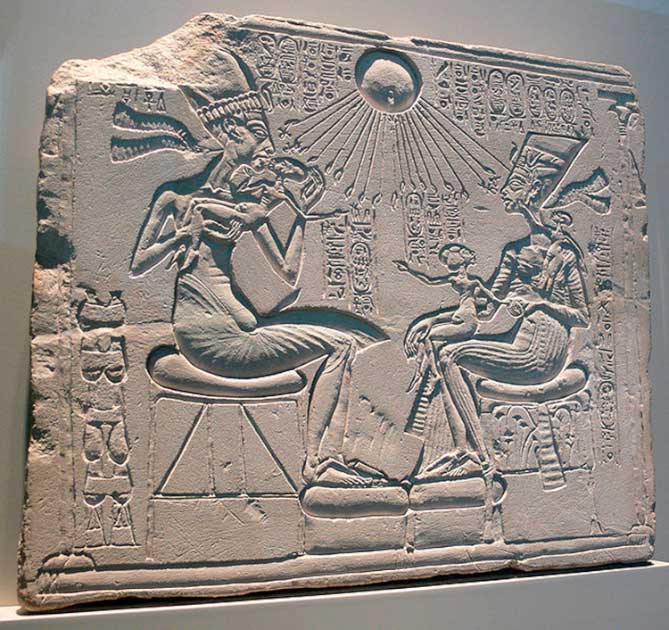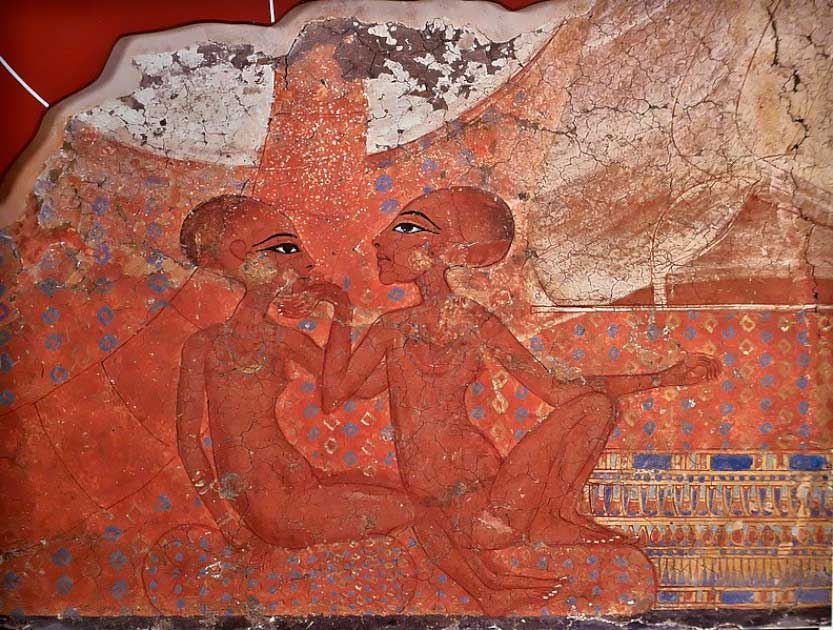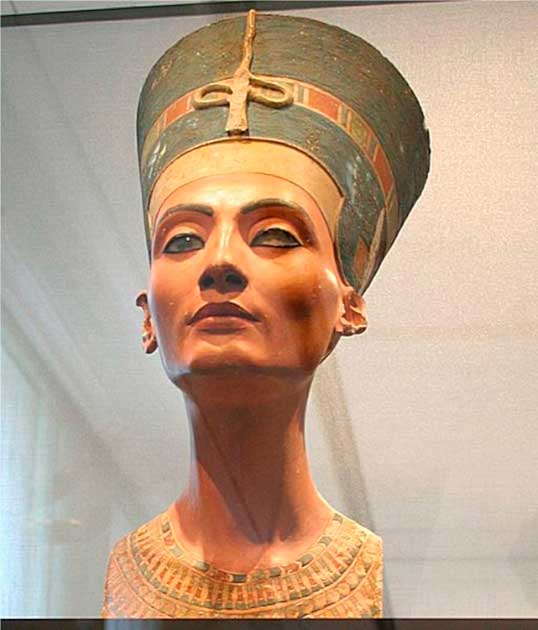It is often said that behind every great man is an even greater woman pulling the strings. Akhenaten ruled the 18th Dynasty of Ancient Egypt from around 1353 to 1334 BC and is best remembered for abandoning Egypt’s traditional polytheism and replacing it with Atenism (a more monotheistic religion based around Aten).
This was a radical move by any standards, as at a stroke Akhenaten threw out the millennia old pantheon of Egyptian gods and it should be no surprise that this huge upheaval did not last long after his death, but in the cult of personality the pharaoh formed family came to the fore. Nefertiti was given prominence never before offered to the wife of the pharaoh.
This shift in religious policy also brought Nefertiti into the forefront of his new religion. When Akhenten died, so did Atenism. His detractors have claimed that his new religion was just a way to promote his ambitious wife. How true is this? Has history glamorized her role in creating a new religion?
Who Was Nefertiti?
Neferneferuaten Nefertiti was the great royal wife of Akhenaten. Today she is most probably ancient Egypt’s most famous queen, putting aside Cleopatra of course. She and her husband reigned over what was likely Ancient Egypt’s most wealthy period.
Not much is known about Nefertiti prior to her marriage. It is believed that she had a sister, Muthbenret. It has been proposed her father was Ay (the penultimate ruler of Egypt’s 18th dynasty) and her mother was a woman called Tey. However evidence tying her to Ay and Tey is spotty at best.

We also do not know exactly when Nefertiti married Akhenaten. It is believed they had at least six daughters including Meritaten, Meketaten, Ankhesenpaten (future wife of Tutankhamun), Neferneferuaten, Neferneferure, and Setepenre.
Nefertiti’s modern fame is unsurprising. She holds the position of having the most surviving appearances on monuments and in other pieces of art. It is this prominence in the artwork of her husband’s reign that has led to accusations that it was she who pulled the strings.
Nefertiti and Heresy
Not long into his reign, Akhenaten brought in a series of sweeping and controversial social and religious changes. These essentially upended the traditional Egyptian pantheon of gods. Aten, once a relatively peripheral and unimportant god, was put on center stage.
Akhenaten created the cult of Aten and then renamed himself to reflect his preferred god. Akhenaten means “One who is effective for the Aten”. He then had workers remove all images and names of previously worshiped gods. In their stead, he had new monuments depicting himself and his family in conversation with Aten built.
Most historians believe Akhenaten’s devotion to Aten was a transparent ploy to consolidate power around himself. By emphasizing the prominence of his god he made himself the mouth of Aten. Anyone who argued with him argued with god.
This new religion didn’t just benefit Akhenaten, and greater authority than ever was bestowed on the entire royal family, especially Nefertiti. Nefertiti was repeatedly shown making offerings to Aten without her husband which suggests she had an unusual level of autonomy in the royal court.
Images even show her smiting Egypt’s enemies and riding around in a war chariot, a motif usually preserved for that of the Pharaoh. It seemed that Akhenaten wanted to place his beautiful queen at the very center of the new religion.
In one shrine a stela (an upright stone slab bearing a commemorative relief or design) depicts Akhenaten and Nefertiti sitting opposite each other with Aten shining down from above. In the Stela Akhenaten holds one of his daughters and kisses her on the lips while Nefertiti’s opposite plays with two of their other daughters: a happy Egyptian family.
What is strange about the Stela however is that Nefertiti is depicted as being only slightly smaller than her spouse. In Ancient Egyptian artwork, female spouses were usually depicted as being considerably smaller, denoting their hierarchical status. The rather small difference in height here suggests the natural difference in height between the sexes, rather than a difference in rank.
Furthermore, the facial features, dress, and posture of the couple are strikingly similar. Both are wearing similar attire with crowns of equal sizes. Aten holds two ankh symbols to the heads of the King and Queen, implying that he sees them as equals.
The Great Hymn stated that the king’s function was to act as Aten’s intermediary on earth. As his wife, this suggests that Nefertiti was Akhenaten’s female equivalent. All of this has been taken to mean that in this new religion worshippers worshiped the royal family as a whole, not just Akhenaten.
Nefertiti as Pharaoh
Backing up the idea that Nefertiti may have had her own ambitions is the fact that she may have become pharaoh after her husband’s death. Many historians believe that before his death Akhenaten promoted his wife to co-regent.

At some point, Nefertiti’s name disappears from the historical record and a new one starts appearing, Neferneferuaten. It is widely believed that Neferneferuaten is Nefertiti and she took over the throne after her husband’s death.
- Role and Power of Women in Ancient Egypt
- Treasure of the Sands: Lost Egyptian “Golden City” Found near Thebes
Unfortunately, unreliable sources and incomplete sources make it impossible to confirm whether it was Nefertiti or perhaps one of their daughters who followed in Akhenaten’s wake. Nevertheless this seems to be a tidal shift in Egyptian politics and religion, one which recognized Akhenaten’s raising of his wife to a pharaonic level.
Not long after Akhenaten’s death, his religion fell with him. He had used Aten to bolster his own power at the cost of seriously upsetting many influential priests and nobles. With him dead there was a push to reinstate the old ways.
During the reign of the child-king Tutankhamun, the old ways were reinstated and Akhenaten and Aten were relegated to being historical footnotes. As many of Akhenaten’s changes as possible were erased from the historical record.
Interestingly some historians believe this erasure of his work started even before Tutankhamun came to power. It has been argued that if Nefertiti did indeed come to power she likely knew how unpopular her husband’s changes had been.
In an effort to ingratiate herself with her people, it may have been she who started undoing her husband’s life work. It has been argued that it was she who had Tutankhamun raised to worship the old gods.
A Powerful Queen
The rule of Nefertiti and Akhenaten is a strange one. Together they rewrote the religion of the world’s most powerful empire and bent its people to their will. The fact that Akhenaten chose to share his power with his wife is certainly strange. Most pharaohs were all about self-promotion.
Sadly Akhenaten never wrote down his master plan so we don’t know for sure whether he did it all on his own or if he was pushed by his wife. Likewise, if Nefertiti was scheming behind her husband’s back there is no historical record of it.
This being said, it seems likely that Nefertiti was a strong force in the royal court of Akhenaten. Her prominence in the religion and artwork of the period makes it clear she was largely seen as her husband’s equal.

Perhaps the best argument for Nefertiti’s role is that while her husband has been somewhat forgotten, she is still one of the most if not the most well remembered of all the Ancient Egyptian rulers. This would certainly indicate that she had an unprecedented level of influence for a royal wife at the time.
Top Image: Nefertiti was raised to an unprecedented height within Akhenaten’s new religion, but also seems to have destroyed it after his death. Source: Damy77 / CC BY-SA 3.0.